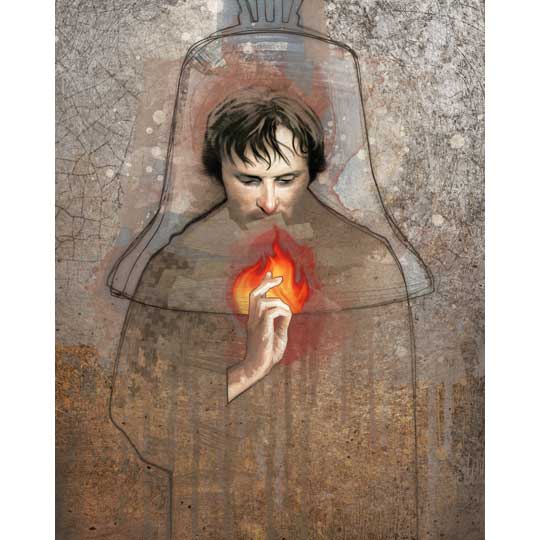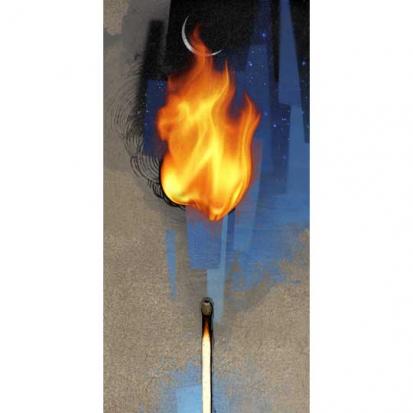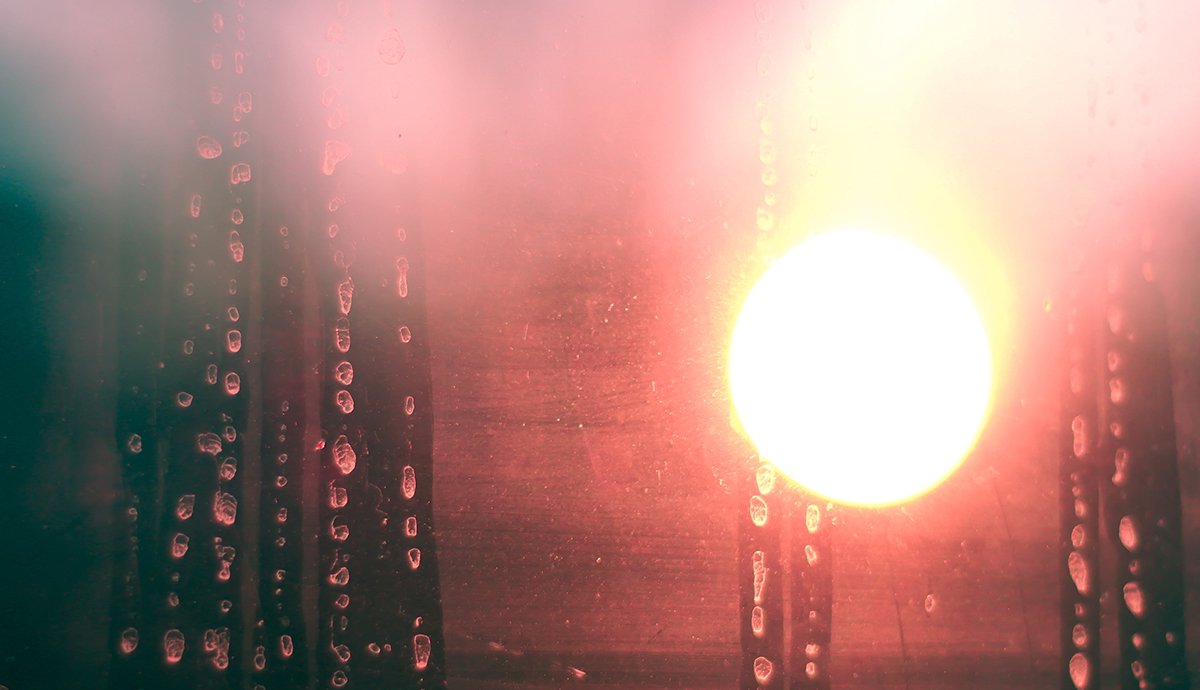Saving the Fire

Si le feu était à la maison, que sauveriez vous?
--Je sauverais le feu. – Jean Cocteau
Somehow the conversation comes around to fire. Our coresident Kevin McIlvoy, a novelist and editor, has posted this quote on his website.
‘If your house was burning and you could only save one thing, what would it be?’
‘I would save the fire.’
-Jean Cocteau, in response to an interviewer.
It’s late at night and we’ve gathered in Bridget’s studio at the Virginia Center for Creative Arts (VCCA), and we’re streaming 70s classics from YouTube and drinking cheap Malbec. Having been in our studios since 8 AM, working on our books and visual art projects and whatever, now it’s time to unwind.
“I don’t know how you could say that!”
Bridget, who is working on a short story collection, seems strangely upset.
“Did you ever have a fire?” she asks. “My house burnt down. We were moving out of it and only had a few things left, but they were precious. That’s a horrible thing to say.”
They had an old furnace, she tells us, which sent flames through a vent in the floor to heat the rooms.
“Somehow it set the house on fire, and we lost a lot of precious things, my father’s early paintings, a portrait of me,” she said. “Those things can never be replaced!”
Jeffery Paine, a soft-spoken older man, has something to add:
“That answer seems very easy to me.”
A world-renowned authority on Buddhism, author of innumerable classic books on world religions, Jeffery is writing a book about Crestone, Colorado, a village in the high Rockies, a uniquely spiritual place where dozens of faiths have a presence, and if he thinks Cocteau is flippant, what does that say about the rest of us?
That shuts me up.
“Okay, okay,” I say finally. “But I was almost in a fire. Almost burned to death. When I was a kid, seven or eight years old. I was going to spend the night with my friend Tommy across the street, but we decided to play at my house instead. In the early evening, my mother looked out the front window and said to my Dad, ‘Herm, the Safford’s house is on fire!’”
 That night, flames burst through the windows of my friend’s house, and the attic, where we would have been playing, was gutted. Flames filled my dreams long afterward.
That night, flames burst through the windows of my friend’s house, and the attic, where we would have been playing, was gutted. Flames filled my dreams long afterward.
“But I would still save the fire.”
Luckily, Ethan Jackson, a visual artist who makes installations involving natural light, chimes in to break the awkward silence.
“When Polynesians paddled from island to island in the Pacific, they did save the fire. They carried live coals with them and kept them burning until they eventually made landfall.”
Which, he adds, led to the extinction of eight-foot tall flightless owls on the Hawaiian islands.
Conversation quickly veers to a new topic: eight-foot tall extinct Hawaiian owls? None of us is exactly sure how carrying fire in outrigger canoes resulted in owl extinction, but the hour is late, and Ethan is breaking out the bourbon.
Not too long afterward, we return our glasses and empty bottles to the barn’s kitchen, and trek through darkness toward the Fellows’ Residence, since we’ll be up at 7 AM for another day of paradise.
Just before coming to VCCA, I finished writing a research grant, four hundred pages of dense, technical prose, with subcontracts, budgets, consultant agreements, manuals, survey results, and two dozen letters of support. One of the most difficult things I’ve ever done in my life.
Compared to that, writing a book is easy, I joke: just a matter of cutting yourself open and ripping out pieces of your liver.
For three weeks, I’m one of two dozen writers, composers, painters and visual artists at the Virginia Center for Creative Arts (VCCA), in Amherst, Virginia, trying to save the fire. We’ve stolen precious time from jobs, family, and other responsibilities to come here; some of us have Airbnb’ed our apartments, and a few are essentially homeless, moving from one residency to another between permanent domiciles. For some the fellowship money makes this possible, for others it’s the protection from emails, texts, bosses, coworkers. For all, it’s a way to get work done with minimal interference, and a bit of companionship, even inspiration, from other Fellows.
Life is simple here: Oatmeal or hard-boiled eggs for breakfast in the Fellow’s Residence, then a few hundred yards stroll to the Studio Barn, then a break at midday to grab a sandwich or last night’s leftovers in the lunchroom, and then retracing the same few hundred yards home at night. Maybe a mid-afternoon break to walk through the marsh past beaver-gnawed trees, or to ride a bike with no brakes down hilly Stage Road, or to drive to Sweet Briar College for a quick swim. Despite rumors of wild parties and affairs, life at VCCA appears pretty tame, with most Fellows heading back to their studios after dinner to put in a few more hours of work.
An old Southern plantation in the shadow of Virginia’s Blue Ridge mountains, the VCCA campus is filled with wildlife, flowering vegetation, and incredible birdsongs at morning and at dusk. A Norfolk and Western train periodically curves on tracks below the eastern flank of the campus, rattling and squealing as it passes. My Nike FuelBand monitor has the lowest number of Fuel Points and steps taken since I was in the hospital a few years ago. But the lack of physical activity masks a time of intense emotion, of being able to give one’s self fully to work for weeks at a time with minimal distraction.
For me, it’s a chance to work on a nonfiction book, a collection of twenty-plus essays, trying to pull them into a coherent narrative. After ten days, I’ve gone through the entire manuscript and written a few new pieces, and need to put it aside, like a ball of dough, to rest for a while. Then I turn my attention to a novel that I’ve been dreaming about for over a decade, for which I’ve sketched out four generations of family trees, and notes on eighteen chapters.
I find myself back in the 1960s, strangely enough, just a few years after Tommy’s house burned down. So long as no one streams Netflix, the wireless network at the VCCA studios is fast enough to research that era, and I quickly find the Estes Model Rockets catalog I’ve been dreaming about, Catalog #691, from 1969, the year of the moon landing, all 132 pages of bright Kodachrome. I flip through the PDF, discovering all the rocket models we assembled in our efforts to Meet the Space Age Challenge—the Astron Alpha, the Astron Drifter, the Astron X-Ray (with its visible payload chamber which could hold a raw egg), and even the Semi-Scale Saturn 5, the same rocket that launched the Apollo 11, which made a successful moon landing on July 20th, 1969.
Were our dreams in those days of being rocketeers, and landing on the moon? Or did we just revel in the possibilities of combustion, whether packing model airplanes with firecrackers or launching coffee cans skyward with M-80s? It seems to me more the latter: we dripped liquid glue across carefully-assembled model cars to watch them burn, and we annihilated our sisters’ Barbies in baths of lighter fluid. We threw matches at one another, we aimed magnifying glasses until piles of leaves began to smolder, we raided our chemistry sets to make gunpowder and stink bombs, and we launched the model rockets not only heavenward but sideways, across neighbors’ backyards, just to see what would happen. The TV News, showing napalm and carpet-bombing, was an accelerant for our explosive reveries.
In my VCCA studio, I relive those days, frantically typing out one chapter after another of my novel. At night, unable to sleep, I find myself scrawling three or four pages of notes that I can barely decode by morning.
My fellow VCCA’ers seem to be engaged in comparable paroxysms of conflagration. Some focus on the incandescence of darkness. Piper Weiss is writing about evil, in a nonfiction book about a beloved tennis coach from her adolescent days who turned out to be a would-be child abductor, and on whom she seems to have had a crush. He rented an isolated cabin and filled it with torture devices, blacking out its windows, and surrounding it with high-tech motion detectors and closed-circuit cameras, and shot himself to death when the police closed in. Lisa Borders is writing a novel about an elementary-school teacher from Jersey, a would-be poet, who goes clubbing by night in the East Village and returns in the morning to her classroom still stinking of the night. And Andrew Hladky, a British artist whose paintings are dark forests of three-dimensional paint that rise high off the canvas, fills the darkness with occasional startlingly bright globs of primary colors like tiny suns.
Others work in the realm of light. Using mirrors and lenses and computer-based modeling, visual artist Ethan Jackson is making progress on bringing the Sun itself indoors, tracking its movements with a mirror set to Julian time, which began in 4713 BCE, so an incandescent globe will inhabit the top of a rotunda, just below the ceiling, unmoving all day. Crestone, the spiritual haven in Jeffery Paine’s book, is high in the Colorado mountains, rising close to the sun, seemingly illuminated with celestial holiness. Mary Page Evans lugs her oils and canvases into the fields to paint rushing clouds as lit by the sun. And Steven Gilbert, a painter in his eighties who has been at VCCA at least twenty-five times, toils on abstract paintings in his light-blasted studio, but, because of his dimming vision, must carry them outside into sunlight to see if his imaginings have been realized in the light of day.
We all are doing something with fire, it seems to me. For the rest of my stay, I can’t help but see everything in terms of darkness and light.
The night of my fire, my narrow escape, Tommy’s mother was down the block visiting a friend. There was a lightbulb in the hall closet, up against some blankets and sweaters, which caught fire. My friend’s toys were melted, his older brother had to jump out a bedroom window. Days after the fire, Tommy and I wandered through the devastation, wobbling across a door that spanned a hole in the second floor landing, making our way upstairs to the attic playroom where armies of toy soldiers had melted into leaden puddles, and the telephone resembled a Dali clock. Breathing an unforgettable stink of wet charcoal and burnt carpeting, we imagined what would have happened if we had played at his house instead of mine that night.
The time at VCCA goes quickly. We work, we do readings and PowerPoint slide shows at night, we drink, we talk, we drive the rural roads, we make midnight burger runs to a nearby Hardee’s. One night we set up for ping- pong in the basement, where we find a dead vole beside the table. After Andrew sweeps it up in an electronics manual, and tosses it outside into the night, five of us spend the evening running around the table, serving, running, receiving. Every few days, Fellows leave and new ones arrive, until finally my time is almost up.
The night before I go, a group of us head out in celebration to the Devil’s Backbone brewpub, up in the mountains, a place full of mounted bears and beery locals. We’re all near the end of our residencies, and soon we’ll go back to our usual lives, but I guess like the ancient Polynesians we’ll do our best to save the fire, to carry it to the next point of landing.
As we get up to leave, a local guy approaches Andrew.
“Hey man, a guy at our table says you’ve been staring him down,” he tells Andrew.
Someone else from his table pulls the drunk guy away before anything can happen to Andrew, who is the least threatening of our crew, and we rush out of Devil’s Backbone, past tall flickering gas lanterns and across the dark parking lot, and then pile into our cars, roaring down the mountain and back toward VCCA, where our home fires are burning.
Links to those mentioned in the blog:
David Hellerstein is a physician and writer in New York. His books include Battles of Life and Death (essays), Loving Touches(novel), A Family of Doctors (memoir), and Heal Your Brain (nonfiction). He has published many essays and stories in theNorth American Review and has been a contributing editor for NAR for over twenty years. While at the Virginia Center of Creative Arts in March 2016, he worked on a nonfiction book and a new novel.
Illustrations by Matt Manley. Matt has been working as a freelance illustrator for over twenty years. His illustration is primarily figurative and symbolic with surrealist leanings, and past client work includes editorial, corporate, medical, book, and higher education. Though in the end his work is technically digital collage, the process integrates both traditional and digital media. Collage elements are original oil paintings and drawings, with occasional scanned found objects and photos added to the mix, all united in Photoshop .
Recommended
Nor’easter
Post-Op Appointment With My Father
Cedar Valley Youth Poet Laureate | Fall 2024 Workshop





